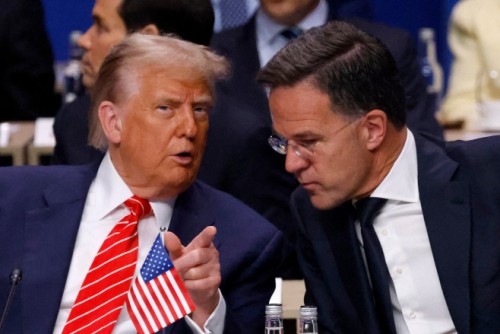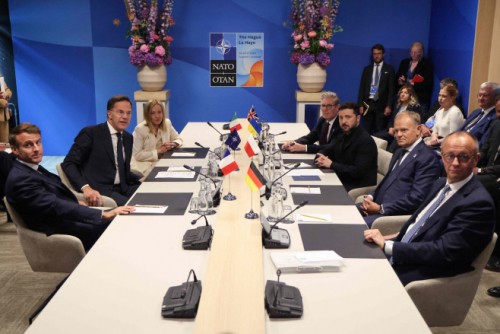 |
| U.S. President Donald Trump speaks during a press conference at the NATO summit in The Hague, Netherlands, on June 25. / AFP, Yonhap News |
NATO’s 32 member states have officially agreed to raise defense spending to 5% of their GDP by 2035—more than double the current 2% target—marking a significant shift in alliance policy driven by security concerns and U.S. pressure.
At the conclusion of the NATO summit in The Hague on June 25, leaders adopted a joint statement committing to allocate at least 3.5% of GDP annually to core military needs, such as troops and weapons, and to submit corresponding annual plans. An additional 1.5% of GDP will be invested in related infrastructure, including cyber defense, protection of pipelines, and upgrades to bridges and roads for military mobility.
 |
| U.S. President Donald Trump (left) speaks with NATO Secretary General Mark Rutte during the NATO summit in The Hague, Netherlands, on June 25. / AFP, Yonhap News |
Together, these “3.5% direct + 1.5% indirect” contributions aim to meet U.S. President Donald Trump’s call for 5% defense spending within the next decade.
“We achieved a major victory here,” Trump said at a press conference, expressing hope that increased spending would lead to more purchases of U.S.-made military equipment.
 |
| U.S. President Donald Trump (left) shakes hands with Ukrainian President Volodymyr Zelenskyy ahead of their meeting during the NATO summit in The Hague, Netherlands, on June 25. / Reuters, Yonhap News |
 |
| French President Emmanuel Macron (from left), NATO Secretary General Mark Rutte, Italian Prime Minister Giorgia Meloni, British Prime Minister Keir Starmer, Ukrainian President Volodymyr Zelenskyy, Polish Prime Minister Donald Tusk, and German Chancellor Friedrich Merz attend the NATO summit in The Hague, Netherlands, on June 25. / AFP, Yonhap News |
NATO Secretary General Mark Rutte, formerly Dutch prime minister, credited the breakthrough to Trump, saying, “All credit goes to President Trump,” and emphasized NATO's emergence as a “stronger, fairer, and deadlier alliance.”
The new target builds on the sense of urgency shared among member states since Russia’s 2022 invasion of Ukraine. While only five or six members currently spend more than 3% of GDP on defense—such as Poland (4.12%) and the U.S. (3.4%)—many, including Italy (1.49%) and Spain (1.28%), fall short of even the 2% threshold, raising concerns about internal friction over meeting the 5% goal.
Trump specifically criticized Spanish Prime Minister Pedro Sánchez for opposing the new target, saying, “They want to stay at 2%. I think it’s terrible. If something bad happens, their economy could collapse.” He warned that Spain might face increased tariffs in ongoing trade talks.
The joint statement also reaffirmed the alliance’s core principle of collective defense, stating, “We reaffirm our unwavering commitment to Article 5 of the Washington Treaty—that an attack on one is an attack on all.” When asked to clarify his stance on Article 5, Trump responded, “I support it. That’s why I’m here. If I didn’t, I wouldn’t be here.”
The statement noted that direct aid and defense industry investment for Ukraine will count toward the 5% spending goal, saying, “Contributions to Ukraine’s security are contributions to our own.”
NATO also pledged to review overall spending trajectories in 2029 based on the strategic environment and military capability updates.
Most Read
-
1
-
2
-
3
-
4
-
5
-
6
-
7





















